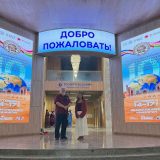Taking to the Streets: The Evolution of the Berlin Art Scene
May 16, 2013
Author: Micol Hebron, Ph.D.
Wilkinson Review Spring 2013
For the last decade Berlin has been an increasingly important locus of the contemporary art scene drawing large numbers of emerging and established artists from around the world. After the financial crash in 2008 even more artists flocked to Berlin where they could find cheap studio space and a thriving arts community. Berlin has become an attractive place for artists to congregate – akin to avant-garde Paris in the 1920s and 1930s – because there are still many empty urban spaces left over from communist era East Berlin. Though East and West Berlin have been unified since 1989 apartment rent remains relatively cheap, and storefront gallery spaces, artist studios, and exhibition spaces can be found for free, or for little money. English is spoken nearly as frequently as German, and the city boasts numerous universities: it has become a foreigner friendly oasis for the contemporary art scene.
This scene is further supported by the presence of some of the most important historic art museums in the world (including the Pergamon, the Alte Nationalgalerie, and dozens of others). One can sense a bit of irony in the once drab and uniform spaces of oppressive models of communism now being used as the sites and sources of a flourishing creative and experimental culture. As Assistant Professor of contemporary art, with an emphasis on New Genres, encompassing performance, video, and installation art, as well as teaching classes in gallery practices exploring the business, curatorial, and creative sides of the art market in multi contextual exhibition spaces, I wanted to travel to Germany to research contemporary practices in the thriving international art scene of Berlin. My trip served several purposes; I conducted field research on contemporary artist practices, exhibitions, and alternative exhibition spaces; I met with artists and art organizers and discussed possibilities for student collaborations with the Berlin Collective (BC), an international artist collective and think tank; and as part of my own scholarly and creative endeavors I presented two performance art workshops and a new solo performance art piece. My plan was to visit immigrant artists, alternative workspaces, artist studios, and exhibition spaces. My intention was to research the ways in which artists in Berlin are living, working, and creating and look for available opportunities for Chapman students to come to Berlin and work with local artists in residence to make or curate an exhibition of contemporary artworks. My goal is to develop a travel course for the summer of 2013 in which Chapman students would come to Germany to study and/or produce contemporary art exhibitions. I was thrilled to learn that there are numerous public communal workspaces that can be rented temporarily, or reserved as part of a cooperative endeavor in exchange for work or help maintaining the space. No such model exists for artists in Los Angeles. Chapman students through studio visits, using available pop-up exhibition spaces, and in collaborating with German and international artists, could experience the curating and producing a contemporary art exhibition in Berlin.
Continue reading this story in the Spring 2013 addition of the Wilkinson Review page 2 …

